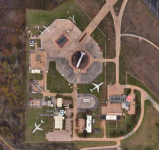DFW Airport's
system does have four designated "interop" TGIDs that are 'in the clear'. Presumably, if there was another major incident, those might be used.
Irving Fire has a designated "DFW Airport" TGID, I presume for interop.
The Northeast Tarrant portion of NTIRN has three designated "DFW Airport Mutual Aid" talkgroups. In the event of an incident requiring assistance, you might hear Grapevine & Euless elements on these.

The airport does have six 700MHz band frequencies
licensed as conventional, specifically for use for training. Those familiar with the northeast Tarrant County area periodically see a large cloud of black smoke rising from the southwest portion of the airport, when training is in progress. The airport has plane structures, including, from what I've read, a mock-up of an A380, in a pit type area. They liberally flood the pit with jet fuel, and then light it up. Crews of firefighters (they host crews from a number of areas, not only just the U.S.) have to get their gear on & put the fire out, check for casualties, etc, as they would in case of a real crash. Once that round is over, (from what I've read elsewhere), gasoline is spread over the foam & water from the previous session, and it's lit for another round. What I was told in the past, including from a "long ago" tour of the airport ARFF facilities with a (then local) offshoot of the old RCMA, the jet fuel they use is often donated. It somehow got contaminated, and can't be used in planes. In lieu of somehow getting it transported back to a refinery, for reprocessing, it instead is given to the airport.

They only do these 'live fire' exercises when the winds are right to prevent spread and, I presume, prevent fogging the residential areas around the airport's perimeter. Since it's simplex, it's well out of range for me unless I'm visiting a friend in Grapevine. What I need to do, time permitting, is when I see the smoke, and I'm in that general vicinity, park at Founder's Plaza and see if I can hear the activity. I'm not sure that there is a closer spot available for public parking. That portion of the airport, besides airport facilities, has a number of distribution warehouses. I've tried monitoring these when at my friend's house in central Grapevine, when I see smoke indicating a training session is in progress, but that's several miles away, and I've never caught anything useful there. I have not tried parking at Founder's Plaza to see if that's close enough. I can't see the smoke from home, so unless I'm out in that area for some reason, and have the extra time (and programmed scanner with me), I have not been able to make progress on these.



